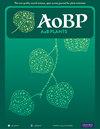通过在水分胁迫期间为光合作用持续供应二氧化碳,五味子(C4)比红花酢浆草(C4)更能耐旱
IF 2.4
3区 生物学
Q2 ECOLOGY
引用次数: 0
摘要
气候变化正在极大地改变全球陆地生态系统的降水模式,因此我们必须了解植物物种对干旱的敏感性如何以及为何不同。Andropogon gerardii和Schizachyrium scoparium都是C4禾本科植物,它们提供了一个模型系统,用于了解决定单一功能类型的物种如何对干旱做出不同反应的生理机制。尽管S. scoparium的叶片含水量更不稳定,但之前的实验表明,S. scoparium在干旱期间能保持更高的光合能力。因此,莨菪抵御干旱的能力很可能来自于其新陈代谢对干旱更强的抵抗力。在此,我们测试了以下假设:(H1)在种群和生物体水平上,Andropogon gerardii 比 S. scoparium 更容易受到干旱的影响;(H2)Andropogon gerardii 的气孔灵活性比 S. scoparium 差;(H3)Andropogon gerardii 的代谢限制比 S. scoparium 多。我们的研究结果表明,实际上是气孔对二氧化碳供应的限制限制了 A. gerardii 在干旱期间的光合作用。根据长期的实地数据、生物量生产和生理气体交换测量结果,Schizachyrium scoparium 比 A. gerardii 更耐旱。虽然 S. scoparium 和 A. gerardii 都避免了光合作用的代谢限制,但在干旱胁迫后期,A. gerardii 的二氧化碳供应量大大减少。两种常见的共生 C4 物种对干旱的反应如此不同,凸显了植物功能群内固有的生理变异性,并强调了对 C4 干旱耐受性进行更多研究的必要性。本文章由计算机程序翻译,如有差异,请以英文原文为准。
Schizachyrium scoparium (C4) better tolerates drought than Andropogon gerardii (C4) via constant CO2 supply for photosynthesis during water stress
Climate change is dramatically altering global precipitation patterns across terrestrial ecosystems, making it critically important that we understand both how and why plant species vary in their drought sensitivities. Andropogon gerardii and Schizachyrium scoparium, both C4 grasses, provide a model system for understanding the physiological mechanisms that determine how species of a single functional type can differ in drought responses, an issue remains a critical gap in our ability to model and predict the impacts of drought on grassland ecosystems. Despite the greater lability of foliar water content, previous experiments have demonstrated that S. scoparium maintains higher photosynthetic capacity during droughts. It is therefore likely that the ability of S. scoparium to withstand drought instead derives from a greater metabolic resistance to drought. Here, we tested the following hypotheses: (H1) Andropogon gerardii is more vulnerable to drought than S. scoparium at both the population and organismal levels, (H2) Andropogon gerardii is less stomatally-flexible than S. scoparium, and (H3) Andropogon gerardii is more metabolically-limited than S. scoparium. Our results indicate that it is actually stomatal limitations of CO2 supply that limit A. gerardii photosynthesis during drought. Schizachyrium scoparium was more drought-resistant than A. gerardii based on long-term field data, organismal biomass production, and physiological gas exchange measurements. While both S. scoparium and A. gerardii avoided metabolic limitation of photosynthesis, CO2 supply of A. gerardii was greatly reduced during late-stage drought stress. That two common, co-occurring C4 species possess such different responses to drought highlights the physiological variability inherent within plant functional groups and underscores the need for more studies of C4 drought tolerance.
求助全文
通过发布文献求助,成功后即可免费获取论文全文。
去求助
来源期刊

AoB Plants
PLANT SCIENCES-
CiteScore
4.80
自引率
0.00%
发文量
54
审稿时长
20 weeks
期刊介绍:
AoB PLANTS is an open-access, online journal that has been publishing peer-reviewed articles since 2010, with an emphasis on all aspects of environmental and evolutionary plant biology. Published by Oxford University Press, this journal is dedicated to rapid publication of research articles, reviews, commentaries and short communications. The taxonomic scope of the journal spans the full gamut of vascular and non-vascular plants, as well as other taxa that impact these organisms. AoB PLANTS provides a fast-track pathway for publishing high-quality research in an open-access environment, where papers are available online to anyone, anywhere free of charge.
 求助内容:
求助内容: 应助结果提醒方式:
应助结果提醒方式:


